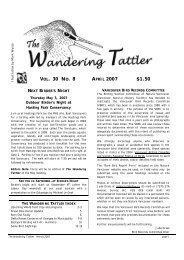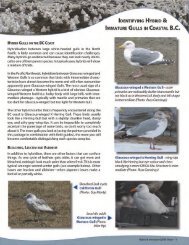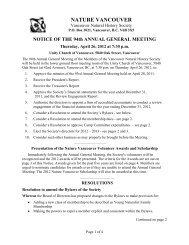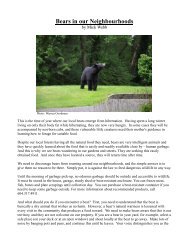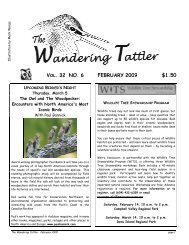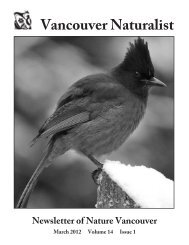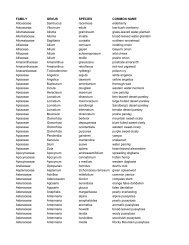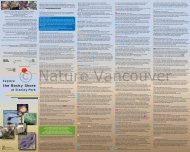Wandering Tattler - November 2011.pdf - Nature Vancouver
Wandering Tattler - November 2011.pdf - Nature Vancouver
Wandering Tattler - November 2011.pdf - Nature Vancouver
You also want an ePaper? Increase the reach of your titles
YUMPU automatically turns print PDFs into web optimized ePapers that Google loves.
BIRDS' EYE VIEW ISFAR MORE COLOURFUL THAN OUR OWNsaid. "The startling thing to realize is that although thecolours of birds look so incredibly diverse and beautiful to us,we are colour blind compared to birds."The brilliant colours of birds have inspired poets and naturelovers, but researchers at Yale University and the Universityof Cambridge say these existing hues represent only a fractionof what birds are capable of seeing.The findings based on study of the avian visual system,reported in the June 23 issue of the journal BehaviouralEcology, show that over millions of years of evolution plumagecolours went from dull to bright as birds gradually acquiredthe ability to create newer pigments and structural colours."Our clothes were pretty drab before the invention of anilinedyes, but then colour became cheap and there was an explosionin the colourful clothes we wear today," said Richard Prum,chair and the William Robertson Coe Professor in theDepartment of Ornithology, Ecology and Evolutionary Biologyand co-author of the paper. "The same type of thing seemed tohave happened with birds."Birds are well known for their stunning plumage colours, whichare created by a diverse set of pigment-based and structural(optical) mechanisms. (Credit: Courtesy of David Kjaer)BIRD SONGS CHANGEWITH THE LANDSCAPEScience Daily (June 22, 2011)Scientists have speculated for years on how birds obtainedtheir colours, but the Yale/Cambridge study was the first toask what the diversity of bird colours actually look like tobirds themselves. Ironically, the answer is that birds see manymore colours than humans can, but birds are also capable ofseeing many more colours than they have in their plumage.Birds have additional colour cones in their retina that aresensitive to ultraviolet range so they see colours that areinvisible to humans.Over time, birds have evolved a dazzling combination ofcolours that included various melanin pigments, which givehuman skin its tint, carotenoid pigments, which come fromtheir diets, and structural colours, like the blue eyes ofhumans. The study shows that the structural colours producethe lion's share of colour diversity to bird feathers, eventhough they are relatively rare among birds.Co-author Mary Caswell Stoddard of Cambridge, who beganinvestigating the avian visual system as an undergraduate atYale, would like to know why birds have not yet developed theability to produce, for example, ultraviolet yellow or redcolours in their feathers -- colours invisible to humans butvisible to the birds themselves."We don't know why plumage colours are confined to thissubset," Stoddard said. "The out of gamut colours may beimpossible to make with available mechanisms or they may bedisadvantageous.""That doesn't mean that birds' colour palette might noteventually evolve to expand into new colours," Prum said."Birds can make only about 26 to 30 percent of the coloursthey are capable of seeing but they have been working hardover millions of years to overcome these limitations," PrumWhen the going gets rough, the tough apparently sing slower.As vegetation reclaimed formerly cleared land in California,Oregon and Washington over the last 35 years, male whitecrownedsparrows have lowered their pitch and slowed downtheir singing so that their love songs would carry betterthrough heavier foliage."This is the first time that anyone has shown that bird songscan shift with rapid changes in habitat," says biologistElizabeth Derryberry who made the finding as part of herdissertation research at Duke University.She compared recordings of individual birds in 15 differentareas with some nearly forgotten recordings made at the samespots in the 1970s by a California Academy of Sciencesresearcher, and found that the musical pitch and speed of thetrill portion of the sparrows' short songs had droppedconsiderably. "I was really surprised to find that songs hadchanged in a similar way in so many different populations."She then used archival aerial photography to see how thefoliage had changed in a subset of those spots, and found thatthe one population whose song hadn't slowed down lived in anarea where the foliage hadn't changed either.The physics is clear, but the biology is a little less certain. Alower, slower song suffers less reverberation in denser foliageand will be heard more accurately. In turn, that means it ismore likely to be copied by young males who are choosing whichsong they will learn. Over generations, that should cause thesong to slow down and drop in pitch as the foliage changes.In the short term however, Derryberry doesn't know whetherthe clearer song wins better territories or mates, althoughThe <strong>Wandering</strong> <strong>Tattler</strong> – <strong>November</strong> 2011 page 9



